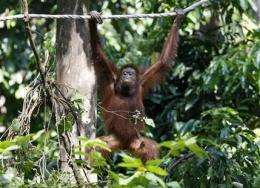Malaysian experiment releases 3 orangutans in wild

(AP) -- Malaysian researchers are testing whether three young orangutans reared in captivity can adapt to life in the wild outside Borneo, while activists insisted Wednesday the experiment was a flawed way of trying to help the endangered primates.
The project is spearheaded by a private foundation that runs Orangutan Island, a research center and tourist attraction in northern peninsular Malaysia. The facility has bred orangutans in captivity over the past decade despite criticism by animal rights groups that conservation programs should focus instead on protecting existing orangutans in the jungles of Borneo and Sumatra.
D. Sabapathy, the center's senior manager, said researchers released three captive orangutans on a neighboring island last week. They are expected to remain there for up to six years before officials determine whether they can be let loose, either in peninsular Malaysia or Borneo.
The project marks the first time that orangutans have been allowed to roam on their own in peninsular Malaysia. Activists estimate some 50,000 orangutans live in the wild in Malaysian and Indonesian territory in Borneo, while another 7,000 can be found on Indonesia's Sumatra island.
The three apes include Sonia, born at the center eight years ago, and two others - Ah Ling, 17, and Nicky, 23 - found by wildlife authorities in Borneo a decade ago and brought to the center. Sabapathy said he was not sure whether Ah Ling and Nicky had lost their mothers or were rescued from poachers.
"It's a rehabilitation program," Sabapathy said. "It's not that we simply will release them anywhere."
The orangutans' lives are expected to change dramatically. On Orangutan Island, they were kept in a 5-acre (2-hectare) enclosure, where they were fed by workers and observed by tourists.
During their stay on the neighboring island, they will enjoy freedom across a 14-acre (6-hectare) forested area, where workers have hidden bananas and tapioca for them to find until they are accustomed to obtaining food such as wild fruit and termites on their own.
Researchers are using binoculars to monitor their behavior, including how they build nests and interact with their environment without human contact.
Marc Ancrenaz, co-founder of French-based conservation group Hutan, said however that resources for orangutan conservation research could be used more effectively elsewhere.
"There's no reason why they should do this. ... We (already) have a wild population" of orangutans in Borneo, Ancrenaz said.
Orangutans in the wild face threats such as the loss of habitat due to illegal logging and agriculture, as well as illegal hunting of the apes for private collections or use in traditional medicine.
The Orangutan Island center houses 25 orangutans, including 17 born there. Orangutans are known to live up to 60 years in captivity, but not as long in the wild.
©2010 The Associated Press. All rights reserved. This material may not be published, broadcast, rewritten or redistributed.

















